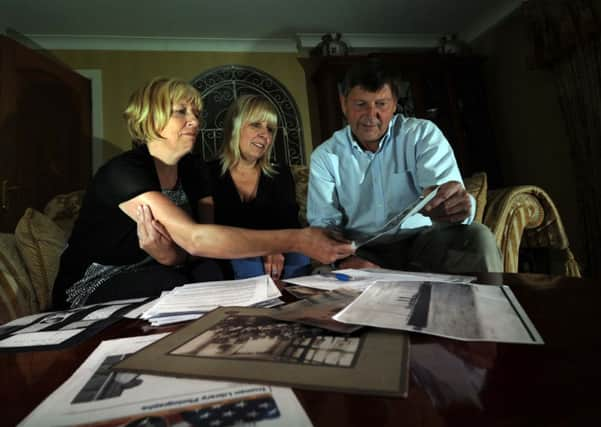Gunning for victory with a future US president


BY the time war broke out in 1914 Tom Louis Taylor was already a soldier.
The son of a Leeds tailor, he had enlisted with the Army in 1911 when he was still only 17 (although he had said he was 18) and two years later he joined the 2nd Battalion Yorkshire Regiment (The Green Howards).
Advertisement
Hide AdAdvertisement
Hide AdHe arrived in Belgium on October 14 by which time the Germans, who had been pushed back following the First Battle of the Marne, were involved in a “race to the sea” with the Allies.
A seemingly unremarkable youngster from a poor, working class suburb of Leeds, he went on to have a remarkable life. John Hamilton, whose wife Jayne is Tom’s great niece, has been piecing together his story and discovered he was in the thick of the action from the outset. “He won 11 citations and twice narrowly escaped death. On one occasion he captured three German soldiers single-handed despite suffering a bayonet wound to his cheek.”
Tom was among the British soldiers involved in the First Battle of Ypres, near the strategically important Belgian town which has become synonymous with the slaughter of the Western Front. “The reports of the first battle are horrendous. They were in the trenches and suffered a terrible bombardment. Within days of getting there these young guys lost weight and their eyes were sunken and these were the ones that survived.”
It was during this battle that Tom was badly injured. “According to reports he was hit by machine gun fire just above both knees,” says John. He returned to England in December 1914 and was treated at the Royal Herbert Hospital in London, where he was forced to spend the next seven months recuperating. His injuries left him with one leg an inch-and-a-half shorter than the other and in March 1916 he was discharged from the British Army, with the rank of Sergeant Major, after he was deemed “no longer physically fit for war service”.
Advertisement
Hide AdAdvertisement
Hide AdTom returned to Leeds with his military career seemingly in tatters. This could very easily have been the end of his war but he was determined to rejoin the fight, as he himself later explained. “They said I was done with fighting but I knew better.”
The story then takes an unexpected turn in April 1917 when the United States enters the war. That same month Tom got a job working in the galley on the SS Celtic, a civilian boat sailing from Liverpool to New York. However, when they reached America he “jumped ship” and immediately tried to enlist in the US Army. “He’s one of several people who are down as having ‘deserted’, so it looks as though there might have been a few of them who decided to go over there and jump ship,” says John. “It’s something he later refers to in an article in the Kansas City Star so it was obviously a deliberate act.”
Initially, though, he was turned down by different sections of the American army owing to his injuries. However, he persevered and travelled to Kansas City where he was accepted by the 110th Engineers, as a bayonet and bomb throwing instructor.
He was then transferred to Battery D, 129th Field Artillery, which was commanded by a certain Harry S Truman – who would later become US President. Tom travelled to France with Truman and his men where he spent the remainder of the war. “He was involved in several skirmishes but luckily he managed to avoid getting injured again.”
Advertisement
Hide AdAdvertisement
Hide AdHe was awarded several war medals including the 1914 Star, the King’s Certificate and the French medaille de la Rennaissance, awarded by the French government to those who performed an act of exceptional bravery to help refugees or the injured.
He remained with the US Army until he was discharged in 1919, after which he returned to America where he started a new life but kept in touch with his former commander.
Over the years Truman organised many reunions with the men of Battery D and Tom became one of his close friends. “Battery D was something very personal for Harry S Truman because he commanded it, and it’s clear that he had a lot of respect for his men and they obviously had a lot of respect for him.”
Tom’s family contacted the Truman library, where he worked for a time, and much to their surprise they were sent a large bundle of letters between the two men. “There are numerous letters from Tom to Harry S Truman,” says John, “he calls him ‘friend Harry’, and although some of it is quite mundane there’s a lot of correspondence between the two of them which shows they were close.”
Advertisement
Hide AdAdvertisement
Hide AdTom maintained his military links and was called up at the start of the Second World War and once again found himself fighting in Europe. In 1948 when Truman was elected president, Tom, along with surviving comrades from Battery D, joined him for breakfast on the day of his inauguration, after which they formed a guard of honour for him in Washington DC. Although Tom returned to Yorkshire on several occasions he settled down in Kansas City where he died in 1970 at the age of 76.
For John, his story deserves to be told. “This was a lad from a humble background in Leeds who goes over to Belgium and is badly injured quite early on. But the fact that he went all the way to America to get back into the war and ends up joining the US Army shows real guts and determination.
“To then meet a young captain called Harry Truman and fight alongside him and to become friends with a president of the United States ... it’s quite something.”